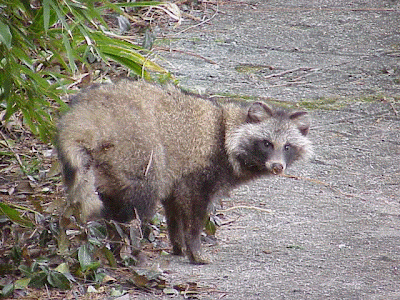


TANAKA TANUKI TONIGHTO!
In my apartment in
His name is Tanaka-san (“Mr. Tanaka” in Japanese—I call him Tanaka Tanuki), and he is a Shigaraki-yaki tanuki. An ornamental ceramic Japanese tanuki, or raccoon dog, manufactured in the
That's one big tanuki

A very cute tanuki family
 I purchased Tanaka-san on my second day in
I purchased Tanaka-san on my second day in
My love affair with tanukis began a few years previously, in

 Tanukis look like raccoons or badgers, but they’re not. Biologically, tanukis are the oldest existing members of the genus canis; they’re not raccoons, they’re actually very primitive dogs. (Wikipedia has an excellent entry on tanukis, and I’m indebted to it for many details.) They only inhabit
Tanukis look like raccoons or badgers, but they’re not. Biologically, tanukis are the oldest existing members of the genus canis; they’re not raccoons, they’re actually very primitive dogs. (Wikipedia has an excellent entry on tanukis, and I’m indebted to it for many details.) They only inhabit
A tanuki climbing a tree
Tanukis are mischievous, jolly, and warm-hearted, adept at disguise and shape-shifting. They’re also gullible and easily deceived. There’s a famous folktale about a tanuki that was sneaking around a temple one dark might, looking to steal some food. When he heard the priest approach, the tanuki instantly turned itself into a tea kettle.
But then the unsuspecting priest placed the tanuki/tea kettle over the hot wood fire, and suddenly the tanuki screamed, changing shape immediately before the startled priest, flinging its arms out and kicking wildly, and the out-tricked tanuki howled off, scorched, into the darkness. Such is the power of this single folktale that tea kettles shaped like tanukis are very popular in
A netsuke tanuki, carved of ivory--and none too happy looking
Tanukis also have huge balls. Testicles, that is. In real life, tanukis have prominent testicles. But in Japanese folklore, tanukis have gigantic testicles, inflatable at will, that can be used conveniently as drums, swinging weapons, or picnic blankets. The comic possibilities are endless. It’s rude rural humor.
And you thought I was kidding
As soon as I learned about tanukis, I thought it was so wonderful that Japanese folklore could produce a creature that was so ridiculous, lovable, mischievous, and cute—in other words, so human. Tanukis are (round-faced) warmhearted practical jokers and inveterate liars who will always confess to the truth, if pressed hard enough; unlike (long-faced) kitsunes (foxes), who will never admit the truth and who honestly enjoy hurting people.
Bill Clinton is a tanuki. George W. Bush is a kitsune. Therein lies the difference between them.
Heartless kitsune! Unforgivable!
A cold-blooded killer sheds crocodile tears: our nation will never recover
(There is still a popular school of thought in
A kitsune shrine
A wicked kitsune tempting a young girl
A carved wooden tanuki, using his belly as a drum
While living in
Mt. Fuji reflected in beautiful Lake Tanuki, Shizuoka prefecture
In the
Later, with the advent of
Tricksters love disguises--that's how you can tell them
But American folklore has no trickster as warm and lovable as the tanuki. The funniest Shigaraki-yaki tanuki I ever saw was on sale in a tourist shop in
Inveterate counterfeiters, tanukis love to pass off leaves to unsuspecting humans as paper money
You’ll be glad to hear that that remarkable karaoke tanuki is presently in my possession. I’ve also heard of a jazz tanuki—a hipster tanuki wearing shades and blowing a saxophone, like the young Bill Clinton on The Tonight Show in 1992.
I used to date a Japanese girl whose grandfather was the Buddhist priest of Shigaraki—yes, the ultimate tanuki town, the town whose sole purpose is manufacturing tanukis for an insatiable Japanese market. She once told me a surreal story of how, in the Fifties, Emperor Hirohito came to visit Shigaraki for the first time after the war. Now Shigaraki is a very small village, and there weren’t enough townspeople to line the parade route for this historic occasion, so what did the town fathers do? They lined the parade route with an endless processesion of Shigaraki-yaki tanukis holding tiny Japanese flags.
The ideal Japanese public: quiet, obedient, uncomplaining--but they're tanukis!
I can only imagine how Hirohito felt when he arrived and was treated to the hallucinatory spectacle of being greeted on either side of the parade route by an unending line of flag-waving Shigaraki-yaki tanukis. That’s the problem with tanukis. Outwardly they can seem like quiet, loyal, obedient subjects—but how do you know they’re not laughing at you behind your back?
Sure, they look innocent, but at night they change
Once I saw a real tanuki, in the inaka (countryside). At 5:30 AM one morning in June 1996, I was climbing a mountain by my house on my way to a shrine when I startled an animal with a long, brown, plume-like tail.
Looks like a fox at first, right?
At first I took it for a fox, but when it swung around and I saw the pointed face and the eyes, I realized I had come across a rare, authentic tanuki. We watched each other for about five minutes (some people say it must have been the shock of recognition, since I'm often accused of being a tanuki), and then the tanuki darted into the underbrush. I followed cautiously, then leaned down and called, in Japanese: "Tanaka-san? Tanaka-san irraishimaiska?" (“Mr. Tanaka? Mr. Tanaka, is that you?”)
That's what I saw
And I swear to God, the tanuki answered back with a sharp high-pitched bark (almost like a yelp), as if he were replying, "Hai!" (“Yes!”)
At that point I realized I’d better get out of there. This could easily be a mother tanuki, and that cute little bark could easily be its warning shot—keep away from my kids! And folks, take it from me, you never want to mess with a feral animal, especially a threatened mother. They possess a ferocity you never want to witness.
 In 1994, Studio Ghibli, the powerhouse Japanese anime studio, released its charming feature Heisei Tanuki Gassen Ponpoko. Since Heisei refers to the reign of the current Japanese emperor, Akihito (Hirohito’s reign was the Showa era), the title translated means, Heisei-Era Tanuki War Pompoko, better known in the U.S. as Pom Poko.
In 1994, Studio Ghibli, the powerhouse Japanese anime studio, released its charming feature Heisei Tanuki Gassen Ponpoko. Since Heisei refers to the reign of the current Japanese emperor, Akihito (Hirohito’s reign was the Showa era), the title translated means, Heisei-Era Tanuki War Pompoko, better known in the U.S. as Pom Poko.
The cartoon is a charming environmentalist fable about a tribe of magical tanukis who are threatened by the encroaching suburban sprawl gobbling up all the mountainous countryside around
(The story is based on the creation of the massive Tama Town development west of Tokyo in 1967, which now includes the city of Hachioji west of Mitaka.)
The tanukis decide to use their ancient magical and shape-shifting powers to scare away the construction crews and greedy land developers, and what ensues is a hilarious farce that pulls out the stops when it comes up to drawing on ancient Japanese folklore to startle and scare the bejeezus out of modern audiences.
A beautiful, phantasmagorical painting by Katsushika Hokusai
The tanukis are lovable, too, and that’s an adjective I don’t use too often.
Pom Poko was the number one domestic film in
But between 1994 and 2005, abject Roman vulgarity made its steady, relentless advance over American culture, like the Nazis bombing
Meet John McCain: as an Air Force POW shot down in 1967 while napalming Vietnamese civilians, Rolling Thunder's Major Charles Rane (William Devane) is the America that has to pay for its war crimes committted in Vietnam; here, after coming home, he's having his hand ground off in a garbage disposal by Tex-Mex border rats hunting for his strongbox of silver dollars, one of the greatest shockers of American cinema--but no blood is ever shown
Our post-Vietnam Captain Ahab: the wound that becomes a weapon (see Philoctetes)
After that assault on common decency, manic raccoon dogs smacking each other with their giant testes like hurling beanbags seemed charmingly old-fashioned, and by August 2005, Disney felt that it was safe to unleash the rural ribaldry of Pom Poko on an unsuspecting American public.
 In October 1999, I attended a multimedia exhibition by noted Japanese anime artist Yoshitaka Amano, creator of Final Fantasy, when he unveiled his new character Hero at the Angel Orensanz Foundation in
In October 1999, I attended a multimedia exhibition by noted Japanese anime artist Yoshitaka Amano, creator of Final Fantasy, when he unveiled his new character Hero at the Angel Orensanz Foundation in
American jazz musician Lew Tabackin releases an album of swinging tanuki music
A pop group called the Tanukis
How omnipresent are tanukis in Japanese culture? There’s even a popular noodle dish in 
It’s a hot noodle soup with deep-fried batter (tempura) sprinkled on top. Kitsune udon, on the other hand, is distinguished by sweetened deep-fried tofu pockets.
When I first went online, in late 1998, one of the first things I did was to research tanukis, and to my amazement and delight, I discovered a site that was nothing but live tanuki cam, all the time. A Japanese couple had discovered a family of tanukis living in their backyard (I think they were in suburban
While living in
Of course, there’s just one thing missing from my life: a real-life tanuki. Would I like one? On a Platonic level, to be sure; but in real life, a tanuki in your house would be hell on wheels.
Don't mess with this tanuki
A tanuki fur coat--oh my goodness!
A tanuki tail (gulp)
In the mid-Fifties, my sister used to keep, as a pet, a raccoon with broken leg that she rescued in the woods and semi-tamed; it was a one-woman raccoon, as my mother used to say. Suffice it to say that a feral raccoon let loose in our Tudor house in
A highway tanuki crossing sign: don't hit the tanuki! I once saw one of these signs on a mountain road in Hyogo prefecture, and it blew my ever-lovin' mind
A pet tanuki? As John Carradine said in The Howling (1981), playing a leering old werewolf: “Wild things ain’t meant to be tamed.”
* * * * *


 Beatrix Potter's exquisite rabbit drawings show just how universal anthropomorphism is in human culture
Beatrix Potter's exquisite rabbit drawings show just how universal anthropomorphism is in human culture















































































No comments:
Post a Comment